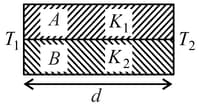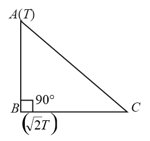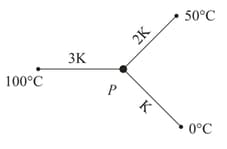Ice starts freezing in a lake with water at when the atmospheric temperature is If the time taken for of ice to be formed is minutes, the time taken for the thickness of the ice to change from to will be:-
Important Questions on Heat Transfer

Two rods A and B of different materials are welded together as shown in figure. Their thermal conductivities are and . The thermal conductivity of the composite rod will be


Consider a pair of insulating blocks with thermal resistances , and as shown in the figure. The temperature at the boundary between the two blocks is

| Heat flow | Electrostatics |
Consider a ball of mass attached to one end of a spring and immersed in water. Assume the complete system is in thermal equilibrium. The spring is now stretched to and the mass is released so that it vibrates up and down. Estimate the change in temperature of water before the vibrations stop.
(Specific heat of the material of the ball and Specific heat of water )
Three rods of same dimensions have thermal conductivities and . They are arranged as shown in the figure below. Then in the steady state the temperature of the junction is

Three rods of identical cross-section and length are made of three different materials of thermal conductivity and , respectively. They are joined together at their ends to make a long rod (see figure). One end of the long rod is maintained at and the other at (see figure). If the joints of the rod are at and in steady and there is no loss of energy from the surface of the rod, the correct relationship between and is :


Temperature difference of is maintained between two ends of a uniform rod of length Another bent rod of same cross-section as and length is connected across (See figure). In steady state, temperature difference between and will be close to:



